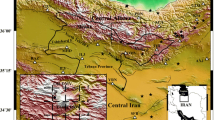Abstract
The crustal structure beneath three seismic stations over Malaysia has been investigated with the application of the group velocity dispersion analysis of the northern Sumatra earthquake data which occurred on 06 April 2010. Eighteen crustal layer models are constructed to assess the structure. Group velocity dispersions have been computed for the recorded earthquake data using a graphical method and modified Haskell matrix method for the models. Both dispersions have been presented for the interpretation of crustal layers. Findings have shown four major crustal layers having thicknesses of 2.5–4.0, 2.0–5.5, 5.0–8.0, and 8.5–9.0 km, while in Terengganu, it has shown three layers. Density, shear, and compressional wave velocities used in models have suggested that the crustal structure of the northern part of Peninsular Malaysia is crystalline. Major crustal minerals are of quartz, plagioclase, and mica. Most layers seem to have upward directions toward Perak from Kedah and Terengganu.











Similar content being viewed by others
References
Ammon CJ, Randall GE, Zandt G (1990) On the nonuniqueness of receiver function inversions. J Geophys Res 95(B10):15303–15318. doi:10.1029/JB095iB10p15303
Anderson LD (2007) New theory of the earth. Cambridge University Press, The Edinburgh Building, Cambridge CB2 8RU, UK
Braile LW, Keller GR (1975) Fine structure of the crust inferred from linear inversion of Rayleigh-wave dispersion. Bull Seismol Soc Am 65(1):71–83
Cobbing EJ, Mallick DIJ, Pitfield PEJ, Teohi LH (1986) The granites of the SoutheastAsian tin belt. J Geol Soc Lond 143(3):537–550
Crow MJ, Barber AJ (2005) Map: simplified geological map of Sumatra, Geological Society, London. Memoirs 31:1. doi:10.1144/GSL.MEM.2005.031.01.17
Dorman J, Ewing M (1962) Numerical inversion of seismic surface wave dispersion data and crust-mantle structure in the New York-Pennsylvania area. J Geophys Res 67(13):5227–5241. doi:10.1029/JZ067i013p05227
Dorman J, Ewing M, Oliver J (1960) Study of shear-velocity distribution in the upper mantle by mantle Rayleigh waves. Bull Seismol Soc Am 50(1):87–115
Dunkin J (1965) Computation of modal solutions in layered, elastic media at high frequencies. Bull Seismol Soc Am 55(2):335–358
Elenean KMA, Aldamegh KS, Zharan HM, Hussein HM (2009) Regional waveform inversion of 2004 February 11 and 2007 February 09 Dead Sea earthquakes. Geophys J Int 176(1):185–199. doi:10.1111/j.1365-246X.2008.03971.x
Ewing M, Press F (1952) Crustal structure and surface wave dispersion; part II, Solomon Islands earthquake of July 29, 1950. Bull Seismol Soc Am 42(4):315–325
Ewing M, Jardetsky W, Press F (1957) Elastic waves in layered media. McGraw-Hill Book Company, New York
Faruk, O., M. A. Hashem, and S. M. Rahman (2012) Analysis and modelling of seismic surface wave for studying the crustal structure of the SE region of Bangladesh. LAP Lambert Academic Publishing, Germany
Hamilton, W. (1979), Tectonics of the Indonesian region, US Geological Survey. Prof Pap 1048:345
Harbury NA, Jones ME, Audley-Charles MG, Metcalfe I, Mohamed KR (1990) Structural evolution of Mesozoic Peninsular Malaysia. J Geol Soc Lond 147(1):11–26
Haskell NA (1953) The dispersion of surface waves on multilayered media. Bull Seismol Soc Am 43(1):17–34
Hutchison CS (1989) Geological evolution of Southeast Asia. Oxford University Press, Oxford
Kieling K, Roessler D, Krueger F (2011) Receiver function study in northern Sumatra and the Malaysian peninsula. J Seismol 15(2):235–259. doi:10.1007/s10950-010-9222-7
Knopoff L (1964) A matrix method for elastic wave problems. Bull Seismol Soc Am 54(1):431–438
Kovach RL (1978) Seismic surface waves and crustal and upper mantle structure. Rev Geophys Space Phys 16(1):1–13
Metcalfe I (2002) Permian tectonic framework and palaeogeography of SE Asia. J Asian Earth Sci 20(6):551–566. doi:10.1016/S1367-9120(02)00022-6
Metcalfe I (2006) Palaeozoic and Mesozoic tectonic evolution and palaeogeography of East Asian crustal fragments: the Korean peninsula in context. Gondwana Res 9(1–2):24–46. doi:10.1016/j.gr.2005.04.002
Richter, B., and M. Fuller (1996), Palaeomagnetism of the Sibumasu and Indo-China blocks: implications for the extrusion tectonic model. In: Hall, R., Blundell, D. (Eds.). Tectonic evolution of Southeast Asia, Geological Society Special Publication. 106, 1, 203–224
Thrower EN (1965) The computation of the dispersion of elastic waves in layered media. J Sound Vib 2(3):210–226. doi:10.1016/0022-460X(65)90109-4
Watson TH (1970) A note on fast computation of Rayleigh wave dispersion in the multilayered elastic half-space. Bull Seismol Soc Am 60(1):161–166
Xia J, Miller RD, Park CB (1999) Estimation of near-surface shear-wave velocity by inversion of Rayleigh waves. Geophysics 64(3):691–700
Acknowledgments
The authors acknowledge the USM Short Term Grant no. 304/PFIZIK/6312025 for the financial support given by Universiti Sains Malaysia. The authors also acknowledge the Malaysian Meteorological Department for providing seismological data.
Author information
Authors and Affiliations
Corresponding author
Appendices
Appendix 1
Haskell and half-space matrices
Notation employed: ω= angular frequency; c= phase velocity; k = ω/c= angular wave number.
For layer m: ρ m = density; d m = thickness; α m = compressional wave velocity; β m = shear wave velocity.
The Haskell matrix components for layer m are:
where
The half-space matrix is
Appendix 2
Example matrix operation
The 6 × 6 \( {B}_{pq}^m \) for the mth layer is derived from the second-order sub-determinants \( {A}^m\;\Big|{\;}_{pq}^{ij} \) of the Haskell matrix by the following convention:
Example: Let us consider a 4 × 4 matrix,
According to the convention, second-order sub-determinant matrix elements are:
Therefore, the 6 × 6 matrix,
Appendix 3
Model error analysis
The standard error of estimate (SE), mean residual (MR), average absolute residual (AR), weighted root mean square error (RMS), and the percent of signal power fit (SPF) are (Elenean et al. 2009):
where obs is the observed group velocity at each period, mean is the mean of the observed group velocities, N is the number of observations at each period, and pred is the predicted group velocity of the current model. Estimated errors of the models are shown in the following tables.
Appendix 4
Crustal abundance properties
Rights and permissions
About this article
Cite this article
Rahman, S.M., Faruk, M.O., Rahman, M.H. et al. Group velocity dispersion analysis in northern Peninsular Malaysia. Arab J Geosci 9, 623 (2016). https://doi.org/10.1007/s12517-016-2632-2
Received:
Accepted:
Published:
DOI: https://doi.org/10.1007/s12517-016-2632-2




